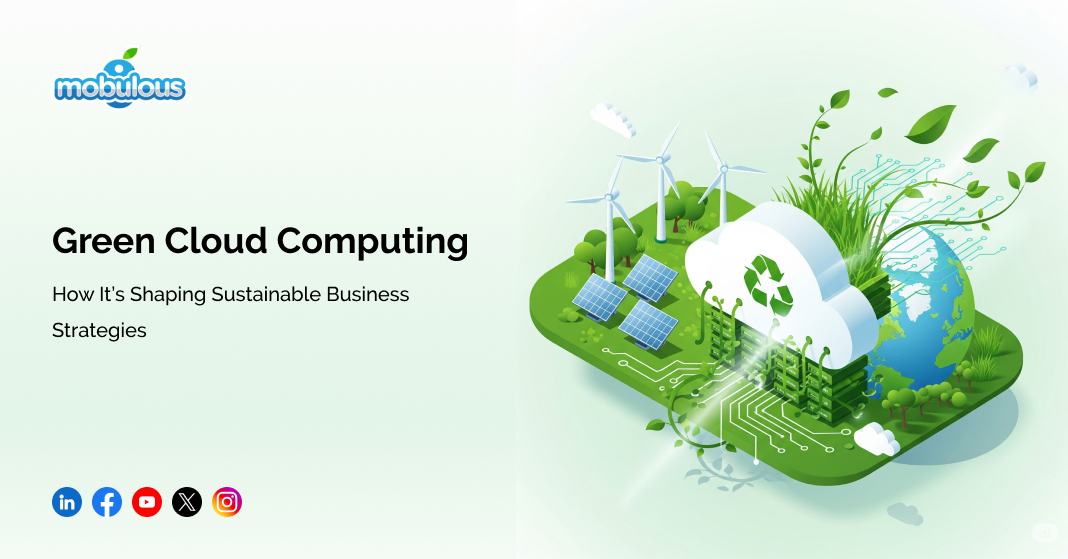What is Green Cloud Computing?
Green cloud computing is the practice of using cloud technologies in a more eco-friendly way to focus on reducing energy use and lowering carbon emissions. Data centers and infrastructure are designed to be more efficient. The goal is to meet digital demands with less harm to the environment. It’s cloud computing with sustainability built in from the start.
Let’s explore how cloud computing is going green and why your business should follow.
How Green Cloud Computing Differs from Traditional Cloud Computing
| Feature | Traditional Cloud Computing | Green Cloud Computing |
| Energy Use | High power consumption | Low, efficient energy use |
| Carbon Emissions | High fossil fuel use | Powered by renewable energy |
| Cooling Systems | Standard air conditioning | Smart or natural cooling |
| Virtualization | Poorly managed resources | Optimized resource utilization |
| Data Center Design | Performance over efficiency | Designed for energy efficiency |
| Hardware Lifecycle | Frequent upgrades, short use | Longer use, recycled parts |
| Operational Costs | High maintenance costs | Low energy-based costs |
| Scalability Impact | Scaling increases emissions | Energy-efficient scaling |
An Android app development company can utilize green cloud infrastructure to scale reliably while minimizing power consumption and carbon output.
The Environmental Impact of Traditional Cloud Computing
Traditional cloud computing uses a huge amount of power, and most of it goes into running and cooling servers in data centers, which often comes from fossil fuels. So, it adds a large amount of carbon emissions to the atmosphere. It also leads to water waste and generates tons of e-waste from outdated hardware.
Many data centers aren’t built with sustainability in mind, as they run inefficient cooling systems, and their servers often sit underused. Old hardware gets tossed too often, and that adds up to a major environmental hit. According to studies, global data centers emit as much carbon as the airline industry. Without change, it’s only going to get worse.
Benefits of Green Cloud Computing
1. Carbon Emission Reduction
Green cloud computing setups use clean energy like wind or solar that cuts down the need for fossil fuels. Smart tech reduces unnecessary workloads. Less hardware and smarter cooling mean fewer emissions. Businesses can lower their carbon output while keeping their systems fully operational. It’s a strong move toward climate goals.
2. Lower Energy Use
Green cloud computing systems are built to use less power. Servers run at high efficiency, virtual machines replace physical ones, energy-smart chips help cut waste, and even cooling systems are optimized. All of this reduces energy bills and shrinks the overall carbon footprint. It benefits both the environment and the business.
3. Cost Savings
Using less power means lower electric bills; that’s the obvious part, but there’s more like fewer machines mean fewer purchases, smarter cooling saves maintenance costs, and energy-efficient systems last longer. All of this cuts expenses over time. The upfront investment pays off quickly and continues to save money every year.
4. Improved Efficiency
Green cloud computing platforms are designed to be lean. They balance workloads in real-time as they shut down unused processes and avoid wasting computing power. The result is better performance with fewer resources, which means less cost, less impact, and more reliable service. It’s efficiency in action, not just theory.
A web app development company can take full advantage of green cloud efficiency to deliver high-performance apps with minimal resource waste.
5. Compliance-Friendly
Many industries now face strict environmental rules. Green cloud computing services help meet those standards by tracking emissions and power usage. They offer data for audits and reports that make it easier to stay compliant. It also reduces the risk of fines and penalties. It’s a smart way to stay ahead of regulations.
6. Longer Equipment Life
Green cloud computing systems avoid unnecessary hardware upgrades by stretching the life of servers through better care. Smart monitoring predicts failures early, whereas proper airflow and cooling keep machines healthy. All this reduces the need for constant replacements, saving money and keeping tons of e-waste out of landfills.
Green Cloud Computing Technologies
These advanced technologies are playing a crucial role in making cloud computing greener.
1. Energy-Efficient Servers
These servers use less electricity than traditional models. They are designed for high performance with low heat output, which means less need for cooling. They also last longer, and this cuts both energy use and replacement costs. It’s a simple upgrade that makes a big difference.
2. Renewable Energy Integration
Some data centers run entirely on green power, whereas others use a mix of solar, wind, or hydro. This reduces dependence on fossil fuels and also slashes carbon emissions. Many providers now invest in their own renewable farms that add reliability and reduce grid strain.
3. Virtualization Tools
Virtualization allows one physical server to act like many, which reduces the number of machines needed. It also cuts energy use. Workloads are balanced more efficiently. Less idle time means less wasted power. It’s a core part of every green cloud computing setup.
4. AI-Powered Management
AI helps data centers run smarter as it predicts traffic loads, shifts workloads to lower-power servers, and adjusts cooling based on real-time data. This level of control means nothing is wasted. Everything runs at peak efficiency, all the time.
With AI-driven optimization, an iOS app development company can build high-performance apps supported by sustainable, energy-efficient backend systems.
5. Liquid Cooling Systems
Traditional air cooling wastes energy. Liquid cooling does a better job by using fluids to pull heat away from hot components. It works faster and uses less power. Some systems even reuse the heat for other tasks, which is a smarter way to stay cool.
6. Carbon Tracking Software
This software shows where emissions come from by tracking power use and server loads. It helps businesses see the impact of their cloud usage. With that info, they can make smarter choices. It also helps with audits and reports.
7. Server Recycling Programs
Old servers don’t have to end up in a landfill. Many cloud providers now refurbish or recycle them, as usable parts are reused and waste is handled safely. It reduces the demand for new materials, which means less mining, less shipping, and less pollution.
8. Data Center Optimization
Every inch of a data center matters. The smart design places servers for better airflow, automation adjusts power use based on load, and sensors track temperature and humidity. All of this makes the space more efficient, cutting costs and emissions at the same time.
9. Edge Computing Support
Edge computing moves processing closer to users, which cuts down on data travel. It also reduces strain on central servers. Less travel means less energy. It also speeds up response times, which is good for users and the environment.
10. Sustainable Design Principles
New data centers are built to be green. They use recycled materials, including solar panels and efficient lighting. Even landscaping can help with cooling. It’s all designed with one goal: to reduce impact while maximizing performance.
For more insights on cloud-native technologies shaping modern software development, check out the blog: “Cloud-Native Technologies And Modern Software Development.”
Challenges in Implementing Green Cloud Computing
1. High Initial Costs
Green upgrades cost money, as new servers, cooling systems, and energy-efficient setups aren’t cheap. Many small businesses can’t afford them right away. The long-term savings are real. However, the significant upfront investment can deter some organizations, which makes it hard to get started, even when the benefits are clear.
2. Complex Migration
Moving to a green cloud computing setup isn’t simple. Older systems need changes, and some downtime is almost guaranteed. The process takes planning and skill, and not every team has the time or expertise. This complexity delays many companies from making the switch.
3. Lack of Internal Expertise
Not every team knows how to run green cloud computing systems. There’s a gap in skills, and training takes time and effort. Without the right knowledge, mistakes happen that slow down progress. Goals remain theoretical instead of translating into actionable steps.
To bridge the knowledge gap, consider working with a team that specializes in sustainable architecture, and hire dedicated developers with green cloud expertise.
4. Vendor Lock-In
Once you’re with a provider, it’s hard to switch. Moving your data takes time and money. You risk downtime or lost data. If that provider isn’t sustainable, you’re stuck, and this lock-in slows down progress toward greener systems.
5. Limited Provider Transparency
Not all cloud providers are honest. Some don’t share enough about their energy use or emissions, and their reports are vague or missing key data. It’s tough to compare options, which makes choosing a truly green provider harder than it should be.
6. Regulatory Ambiguity
Green rules vary by country. Some laws are weak or unclear. Others don’t exist at all, which lets some providers claim to be green without proof. Businesses get confused, and they struggle to know what really counts as sustainable.
How to Transition to Sustainable Green Cloud Computing?
1. Audit Current Infrastructure
Start by checking what you have. Look at how much energy your systems use. See where you’re wasting resources. Find the most power-hungry parts. This audit gives you a clear starting point and helps you plan smarter changes.
2. Choose Green Providers
Pick cloud providers with strong sustainability records. Look for those using renewable energy. Check if they share real data. Google, Microsoft, and AWS have clear goals, and their reports show they’re serious. That kind of transparency matters.
3. Optimize Workloads
Avoid running unnecessary workloads continuously. Turn off unused systems, schedule heavy tasks during off-peak hours, and shrink capacity when demand is low. These steps reduce power use and cut your bills. Simple changes make a big difference.
4. Embrace Virtualization
Use one machine to run many tasks, and that’s what virtualization does. It saves power, and you don’t need as much hardware. With fewer devices running, energy use drops. It’s efficient and smart. Many cloud providers already offer this.
5. Enable Auto-Scaling
Set your cloud to scale up and down automatically. During busy times, it adds power. When things slow down, it scales back to avoid waste. This ensures resources are used efficiently, reducing both energy use and costs.
6. Monitor and Measure
Track your usage by using cloud tools or third-party apps. Look at power, emissions, and server load. Real numbers help you improve. You’ll see what works and what doesn’t. Regular tracking keeps you on course.
Start your sustainability journey with an expert cloud migration and hosting company tailored for green infrastructure.
Real-World Examples of Green Cloud Computing Providers
1. Google Cloud
Google Cloud runs on renewable energy. It’s been carbon-neutral since 2007, and its data centers use smart systems to cut power use. They plan to run on carbon-free energy 24/7 by 2030, which is a serious goal, backed by clear steps.
2. Microsoft Azure
Azure uses wind and solar energy. Microsoft plans to be carbon-negative by 2030, and its cloud systems use AI to cut waste. They’ve also pledged to remove all historical emissions by 2050, which is a long-term commitment.
3. Amazon Web Services (AWS)
AWS is working to be 100% renewable by 2025. They’ve built solar and wind farms, and their data centers are highly efficient. AWS offers tools to help users track cloud emissions. That helps customers stay green, too.
4. IBM Cloud
IBM plans to reach net-zero emissions by 2030. They use efficient hardware in every data center. IBM invests in smart cooling systems. They also publish clear sustainability reports that make their progress easy to track.
5. Alibaba Cloud
Alibaba Cloud powers some of its centers with solar energy, and its cooling systems are smart and efficient. They’re adding renewables across Asia, and their annual reports show how they cut emissions, which shows accountability.
How Businesses Can Adopt Green Cloud Computing
1. Start Small and Scale
Don’t change everything overnight. Pick one app or one system, move it to a green setup, watch what happens, learn from it, then grow step by step. This approach keeps things simple and low-risk.
2. Involve Leadership
You need top-level support. Executives should know the goals as they help set budgets and priorities. When leadership cares, the whole team follows. Green goals become company goals that speed up real progress.
3. Train Your Team
Give your IT team the right skills. Teach them about green tools and systems. Cover things like efficiency, monitoring, and vendor choices. A trained team makes better choices that lead to real results.
4. Set Clear KPIs
Decide what success looks like. Pick goals like reduced energy use or fewer emissions. Track them often and share results with your team. Clear KPIs turn ideas into actions. They also show what needs work.
5. Prioritize Green Vendors
Look beyond price and features and ask about energy use and emissions. Check their reports and choose vendors with real sustainability goals that send a strong message. It also supports long-term change. When choosing green vendors, prioritize those offering portability and open standards to avoid long-term lock-in.
6. Review Regularly
Tech changes fast, and today’s best solution might not be the best next year. Review your setup often and check your progress. Update your tools and stay flexible; that’s how you keep improving.
For insights on how cloud computing influences mobile app development firms, don’t miss the blog, “The Impact of Cloud Computing on Mobile App Development Companies.”
Conclusion
Green cloud computing isn’t just a trend, but it’s a strategic move toward sustainability, cost savings, and operational efficiency. By adopting smarter systems powered by renewable energy, businesses can reduce emissions, lower expenses, and stay ahead of environmental regulations.
The transition doesn’t have to be overwhelming. Start with a simple audit, choose providers committed to clean energy, and make incremental changes. Every step counts.
The future of business is green, and cloud computing is leading the way. Start today, as small actions can have a big impact.
FAQs – Green Cloud Computing
Q1. What is meant by green cloud computing?
Green cloud computing means using cloud services in an eco-friendly way. It helps save energy and reduces waste. It also uses renewable energy sources. The goal is to lower the environmental impact of cloud services, including the energy used by data centers and the carbon emissions they produce.
Q2. What are examples of green computing?
Green computing includes using energy-efficient devices. It also means recycling old electronics. Using clean energy is another example. Running low-power software helps too. Working from home saves travel energy. Using virtual servers instead of physical ones also helps. All these actions reduce harm to the environment and save energy.
Q3. Why is IT called green computing?
IT is called green computing because it helps the environment. It reduces energy use and electronic waste. It promotes eco-friendly practices, including using less power and safer materials. The word “green” means good for the planet. So, green computing is about making technology safe for nature and people.
Q4. What are the benefits of green computing?
Green computing helps save energy and money. It reduces electronic waste. It also lowers pollution. Companies can follow environmental laws better. It improves their public image. Green practices protect natural resources. They also help create a cleaner and safer planet. These benefits make green computing good for business and nature.
Q5. What are the green cloud computing companies?
Some cloud companies use green practices. These include Amazon Web Services (AWS), Microsoft Azure, and Google Cloud. They use clean energy for data centers. They also design systems that save power. These companies help customers lower their carbon footprint. Their goal is to reduce the environmental cost of cloud services.
Q6. How green is cloud computing?
Cloud computing can be greener than old systems. It uses shared resources more efficiently. But it still needs a lot of energy. The type of energy used matters. Clean energy makes it greener. Cloud services also reduce the need for hardware, helping cut waste and save power over time.
Q7. What are the types of green computing?
Green computing has many types. One is using low-power hardware. Another is writing energy-saving software. Data centers can also be designed to save energy. Recycling e-waste is important too. Using solar or wind energy helps a lot. All these practices reduce the negative impact of technology on nature.
Q8. What are the disadvantages of green computing?
Green computing has some downsides. It can cost more at first. Older systems might not work well with green tech. Some green products may be less powerful. Greenwashing is also a risk that means fake green claims. Also, keeping up with new eco-tech is hard. Some green options are not widely available.
Q9. How to apply green computing?
You can start green computing in many ways. Use energy-saving devices. Recycle old electronics properly. Switch to cloud services. Turn on power-saving modes. Print less to save paper. Work remotely when possible. Choose renewable energy if you can. These steps help reduce waste and save energy in daily computing.
Q10. What is the history of green cloud computing?
Green cloud computing started from green computing. The Energy Star program began in the 1990s. It promoted energy-saving hardware. Later, cloud services grew in the 2000s. People saw the need to make them eco-friendly. This led to green cloud computing. It focuses on running cloud systems in a cleaner way.
































